In the past 15 years, Memphis has pursued an NBA team and spent $250 million for Pyramid improvements and construction of the FedExForum to lure the Grizzlies.
We have devoted years to considering how to make our convention center more competitive, we analyzed the best places for a new $400-500 million facility, and we convened a special city-appointed committee to consider financing and next steps.
We have widely debated a suggestion that Memphis should build a new football stadium and city government obtained advice from experts about what it could be and what it could cost. We convened a special city-county committee to work on the reuse of The Pyramid and for six years worked on a plan that led to its redevelopment.
We have cumulatively waived about $750 million in property taxes for any company that wants to come here, including those that failed to pay a living wage. We have put together a unique collaboration between City of Memphis, Shelby County, and State of Tennessee to put $179 million into a new Electrolux manufacturing plant.
Thinking Ahead
And yet, in all that time, there’s been no communitywide discussion about the state of our now 49-year-old airport, the single largest economic engine for our region – generating about $28 billion a year in economic impact and creating about one out of three jobs.
There is no argument that the 1963 design of Memphis International Airport was stunning and graceful, but these days, parking garages have largely obliterated the dramatic view of the airport that was once the stuff of postcards and magazine covers. Because of the design, many of us have simply coped with the frustration that comes from the outdated interior design of its ticketing area, security queuing, waiting areas and concourses, and an overall travel environment that routinely fails to live up to modern expectations.
We have done little to develop the promise of aerotropolis into the reality of a high-performing nexus for entrepreneurs, high tech companies, convention meeting space, and multi-modal logistics in a thriving Whitehaven. Maybe that’s not a surprise considering the inattention to improving our airport’s place in its competitive context.
If we can find the civic will and the community pride to consider our future needs when it comes arenas, stadiums, and convention centers, surely we can convene a broad-based group to bring the imagination, energy, and commitment that are needed to decide what we, as a community, can do to have an airport that presents a positive face to the world, that is competitive within the context of today’s airports, and sends a clear message that we are doing whatever it takes for our single largest economic generator to be among the world’s best.
It’s Time
There’s no time like the present. FedEx is investing billions of dollars into its three-hub strategy for the future, and it is based on our airport, DeGaulle airport in Paris, and the Guangzhou, China, airport. There are other cities in the U.S., notably Indianapolis, that are making investments in their airports and in their airport areas with the intention of maximizing their impacts, but also with the thought that they might someday lure our biggest employer there in the post-Fred Smith era of FedEx.
But the truth is that our biggest enemy is not those cities, but our own complacency and the symbol for it is our airport itself.
To give you an idea of what our competitive context is, we’ll be posting this week photographs of the airports in relevant cities.
Austin
Indianapolis
Charlotte

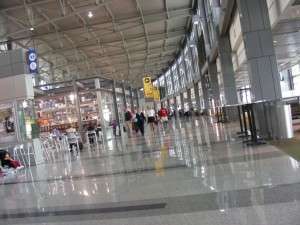
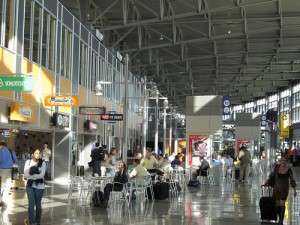

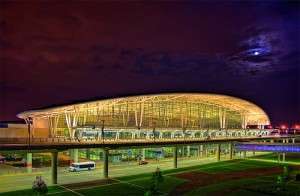
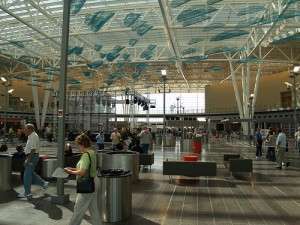
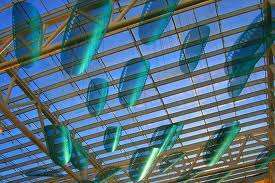
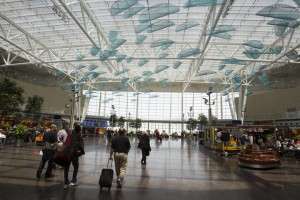
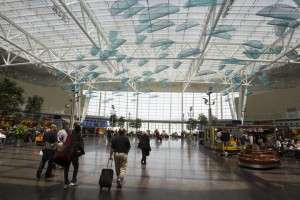
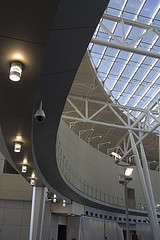
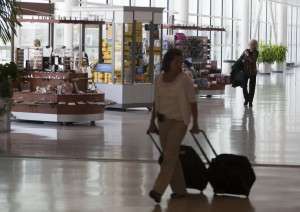
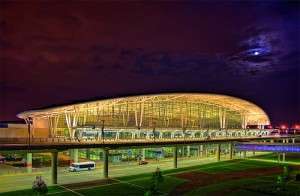
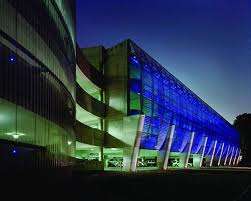
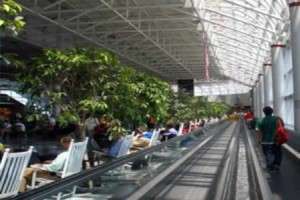
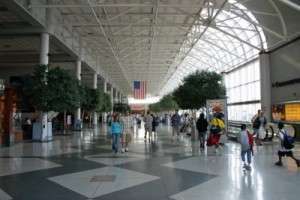
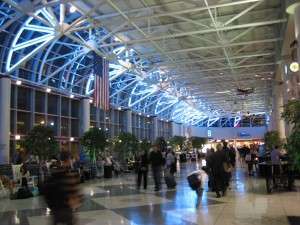
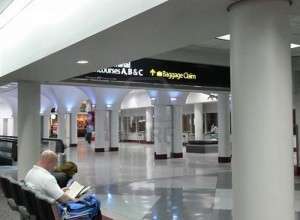
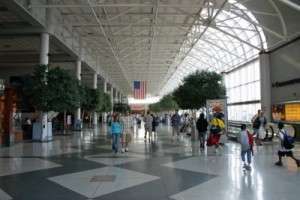

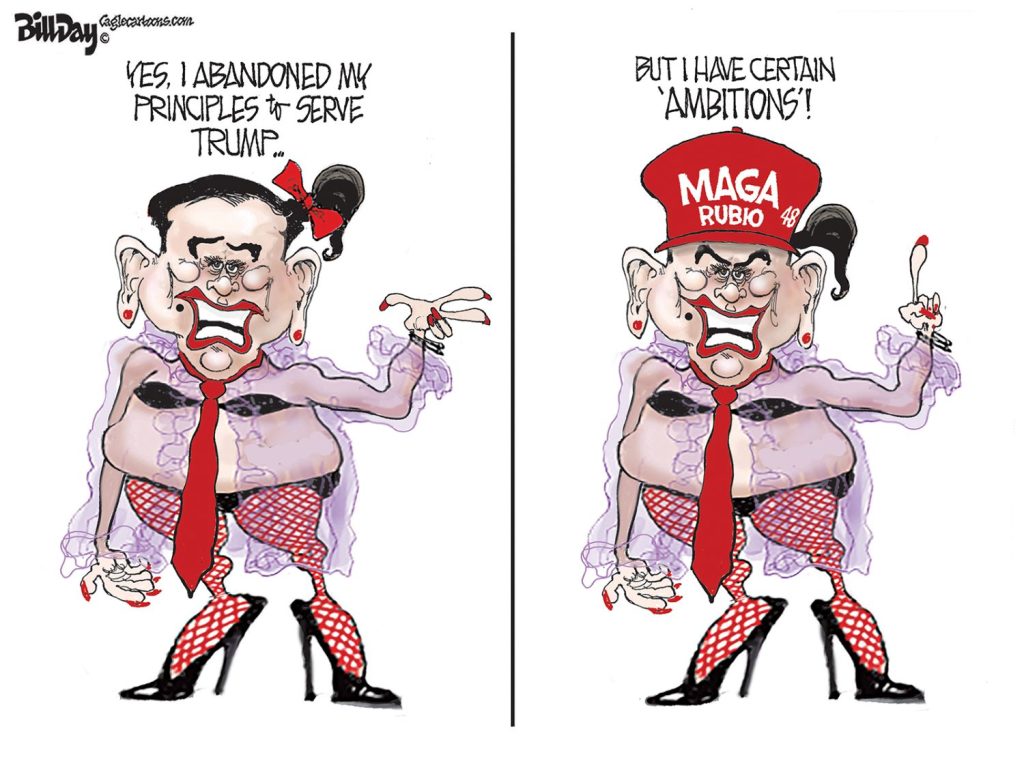
SCM well said. One major issue we will have in building a new facility is that our bond rating has been lowered due to Delta’s service cuts. This fact alone will substantially increase the cost of any new improvements at the airport. When the CA asked the Airport Authority for a reaction to the rating agency downgrade the Aurtoity said not to worry because we don’t plan to build anything. Thats right not a plan to increase connecting traffic ( which through landing fees is how the airport supports its self).
The first course of action for the airport needs to be getting its house in order. Successfuly managing a decline is not good enough.
What action steps is the airport taking to increase connecting traffic ?
Are we marketing the airport as a great place to connect to Delta’s frequent flyers? We must do so because as traffic decreases our ability to build new projects declines.
This week I flew into Nashville. I heard country music and received recorded welcomes from country recording artists.
In New Orleans I hear jazz. An airport helps to brand a city.
Many years ago the suggestion surfaced that we play Memphis music at Memphis International. Larry Cox was very opposed. He said what if someone is attending a funeral we don’t want to be playing happy music.
The airport is where we should start our branding of the city.
Putting a musical note on the rental car facility strikes a sad note when we could be playing Memphis music in the airport. BB King, Justin Timberlake, Craig Brewer and other should record welcoming messages.
It would cost very little and would fit well with the smell of BBQ that I equate with landing in Memphis.
My 11 year old son this weekend told me as we were walking through the airport that he thinks its the worst airport he’s been in. He too associates the smell of bbque with the airport, that and narrow dark concourses. When an 11 year old starts ripping our airport as being out of date, we’ve got problems. Piping in Memphis music is an obvious, low cost, good idea. People that are coming or going to funerals probably don’t want to see CNN on every screen detailing the latest deaths in the Middle East, or seeing people yuck it up while eating q and drinking beer in the restaurants, but we aren’t stopping those things. The aesthetics of that airport are horrendous by any standard. Of course, if this city is anything it is a city that doesn’t understand the importance of having public spaces that look good.
Forget all those other cities! The problem isn’t the airport — it’s the airlines and the industry, and possibly, just possibly, Memphis as destination and location — and to make a new one the solution in that environment would be to engage in costly civic churn, with little effect.
By the way, it has dark concourses because it’s empty.
Gates: The concourse was shrunk more than 20 feel when the airport was built to save $1 million. It’s forever made it feel claustrophobic and constricted. Penny wise and pound foolish. Perhaps, just perhaps, some other airlines would be attracted to a new airport and the opportunity to be part of something new and exciting rather than something that’s relatively dreary.
Logically then, we should be getting new bus companies coming into Memphis now that we have a gleaming LEED-certified bus terminal.
Anyway, who’s lobbying for a new airport?
Hilarious. We could become the bustropolis. The bus terminal is fine but it’s not an economic engine, and as we said, if we can spend a lot of time and energy talking about convention centers, we can surely spend time thinking through what we need to have in an airport that succeeds in its competitive context. What if we talked about a new airport that had a significant conference center and opened up new economic opportunities…or adjacent buildings for high-tech centers, FedEx-related suppliers, or companies like medical devices that find great benefit in overnight delivery? There is a different vision that we can execute for the “airport city,” but it begins with thinking anew.
We’re not lobbying for anything, but we do think we often are guilty in Memphis of getting to the wrong answers because we’re not asking the right question. We just think it’s a question worth asking if we are talking about being one-third of the world-class hub strategy for FedEx.
Always good to especially hear from you.
No one is talking about a new terminal. A new terminal will not attract new airlines. Airlines are driven by origination and destination traffic. Not pretty buildings.
The airport could be made to feel less like it belongs in a Hollywood portrayal of 1950s Mississippi if we were to use color and music to lift the space.
Doing so will take not take much money but will require vision and creativity.
In other words it won’t happen.
Sorry to say this but when we say we want art in the airport we don’t mean finger painting by elementary students. That is often what we get and it makes us seem small townish.
Love,
The flying public
Keep the terminal. Fix the concourses which are pathetic. It’s not a paintup fixup project. It needs a total facelift. It’s like Fed Ex Forum. We didn’t know what a great arena looked like until we built one. Now we need to build a great airport. This one was built for 1950 Mississippi and its capital city.
Have to agree with Frank on that one. The concourses themselves need to be blown up and rebuilt into something more spacious and less cavernous than what is already there. Unfortunately, the airport’s latest Master Plan doesn’t give us much anything that looks promising (even with the expansion of Concourses A and C as well as proposed interior renovations to the existing terminal as a whole):
http://memphisairport.org/about/masterplan (go to Executive Summary, beginning with slide 34 “Passenger Terminal Planning”)
Is it just me? I do pick my connections based on which airports I consider the best, most spacious, etc. If I have to spend a lot of my life in airports, I want to pick the ones that positive for my day.
Another consideration is that the airline Memphis wants more than any is Southwest which has built itself by providing low-cost service to lower cost (aka “crappy”) airports in America. Building a billion-dollar trophy airport for Southwest — especially since they won’t want to pay for it — doesn’t appear wise.
@GatesofMemphis True, but that doesn’t mean airports shouldn’t put money towards at least modernizing their existing facilities as opposed to building completely new ones. Examples of such modernization projects taking place right now include Dallas’ Love Field (Southwest’s flagship hub), Birmingham’s Shuttlesworth Airport, and Little Rock’s soon-to-be-called Clinton National Airport.
Love Field: http://www.lovefieldmodernizationprogram.com/
Birmingham-Shuttlesworth: http://www.flybirmingham.com/terminal-modernization-project/
Little Rock National: http://www.2020visionplan.net/
Barack Obama Memphis International Airport. What a great way to forge into a new Memphis than by honoring our first Black President.
Now I don’t expect the six white Republican males that (+ one female Democrat) make up the board to like the idea. But if NYC can honor Kennedy then Memphis could honor Obama.
Or Martin Luther King,Jr. Memphis International Airport?
Thoughts????
How about Prince Mongo Interplanetary Spaceport?
“Hilarious. We could become the bustropolis. The bus terminal is fine but it’s not an economic engine, ”
We have gotten a new bus line in town: MegaBus. I’ve ridden on it up North, and it’s a major improvement on Greyhound.
Just provide reasonably priced ticket fares first. Our family could fly into a hole in the wall and be fine with that as long as we get a good deal on the tickets.
No disagreement here, but we don’t think it’s either-or.
@James Owens I agree with that.
I was thinking “if ….then” more than “either or”
Aaron:
We understand. We think we’ve got to do something to create more passengers, and that a reimagined airport would do that, one like we described in response to Gates.
We should try to avoid mixing messages here and the purpose of renovating our decidedly dated airport facility.
While the quality of the airport as a public space has a definite impact on travelers, I cannot imagine that it has a significant impact on demand or passenger counts. When I am traveling, I have never once considered the aesthetics of an airport as a determining factor when planning my route. More often than not it is dictated by the airline that I am using. If and when my travel involves interchange between multiple airlines, cost and schedule are the determining factors. Convenience, cost and schedule determine the vast majority of the public’s travel choices whether it be a power meeting or a family vacation. I question whether a more contemporary terminal would in fact yield new or better service. There are too many underutilized or mothballed concourses and terminals across this country that counter that approach. Cincinnati and Pittsburgh both spring to mind.
Personally, in light of recent reductions by Delta and the glut of gates it has left, I personally would rather the current concourse layout be demolished in phases and replaced with a smaller, more efficient and higher quality footprint. Oklahoma City undertook just such a program several years ago as part of an extensive modernization program. Fewer (empty) gates would be well worth a higher quality experience once beyond security. As for the terminals, they are actually still quite attractive per their original design. A few moves to replace poorly designed elements from over the years since their construction to allow for better lighting and visibility would go a long way.
* First of all, the airlines should pay for the airport (through landing fees and gate usage fees)
* Second of all, a “grander airport” only makes sense if there were more passengers.. and passengers won’t come just because they like the airport.
* Third, the way to get more passengers is as follows:
a. more inbound because people want/need to come to Memphis for a1) tourism or a2) business.
b. more outbound because people can afford it and want/need to travel for b1) tourism or b2) business. (Obviously (a2) and (b2) are closely related to the success of Memphis-based businesses and Memphis branches of other businesses.)
c. more transfer/connecting passengers because the airlines have found Memphis to be a profitable hub- quick and easy connections, quick flight-turnaround, “competitive” landing fees, efficient passenger and baggage handling facilities. But, usually airlines won’t invest in a hub (remember a passenger airline “hub” is a schedule that affords convenient passenger connections, plus the gates, equipment and manpower to facilitate the connections) unless it has substantial traffic originating or terminating in the same city, which points back to items (a) and (b).
d. Making a prettier, more grandiose new terminal does not generate more passengers (see comment by Anonymous, March 26, 2012 at 10:30 am.)
BOTTOM LINE- two inter-related causal sequences of factors:
1. Memphis becomes more attractive to businesses (and there are many factors involved here obviously)
=> 2. more Memphis businesses
=> 3. more air travel to/from Memphis
=> 4. more demand to increase capacity of the Memphis airport (and upgrade at he same time) AND more income for the Airport Authority (user fees and concession fees, etc)
=> 5. Memphis Airport Authority expands and enhances the airport.
1. Memphis Airport Authority decides to invest in attracting a “Hub partner” through the following- “competitive” landing fees and gate fees, quick and easy connections, quick flight-turnaround, efficient aircraft, passenger and baggage handling facilities (gates, equipment and manpower), passenger communications systems (flight status monitor terminals, and “effective public address systems).
=>2. Memphis Airport Authority courts potential hub partners
=>3. Some major airline decides to make Memphis a hub
=>4. volume of connecting passengers increases
=>5. Memphis Airport Authority expands and enhances the airport.